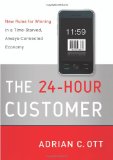Remember when people used to pay attention to one thing at a time and give each one the time it deserved? Well, those days are over, and you’d better design your products to deal with it. That’s the message of The 24-Hour Customer by Adrian Ott, an insightful book about designing your product or service based on where and when customers will use it.
Ott categorizes products on time and attention axes, creating a 2 x 2 matrix. Here’s how the four quadrants break down in terms of people’s propensity to allocate time and attention to them:
- Low time, low attention = Value
- Low time, high attention = Convenience
- High time, low attention = Habit
- High time, high attention = Motivation
The idea is to figure out what quadrant your offering is in, or what quadrant you want it to be in, and design the offering accordingly.
The convenience quadrant: FedEx
For example, FedEx shipping is in the convenience quadrant. People give shipping a lot of attention (“We’ve got to get this package to FedEx by 4PM so it gets there tomorrow!”), but little time; in fact, they’re using it to save time.
All of the facets of a convenience offering must require little time. For example, if people have to wait in a long line to drop off their packages, they’ll get frustrated with FedEx. Similarly, FedEx should put its drop-off sites in convenient locations so people don’t have to go far out of their way.
For an offering to be convenient, it has to be available when the person needs it. Ott calls an event that causes a person to need a product a trigger. For example, the trigger for a small business owner to ship a document is after they’ve printed it. Note that FedEx bought Kinko’s so small business owners could create, print, and ship a document all in one place: FedEx Office.
The quadrant your product is in also determines what your company needs to focus on. For example, a company offering a convenience product must keep investing in technology to make it simpler and faster to find, buy, and use the product. Otherwise, a competitor will do so and become the more convenient option: if UPS offered online product tracking and FedEx didn’t, shippers would use UPS to save time tracking packages.
You also need to think about customers’ divided attention. You can no longer assume that people are giving your offering their full attention: they may have one eye on their iPhone while they’re filling out the FedEx shipping label. As a result, you need to provide simple choices to keep customers from becoming overwhelmed and giving up on using your offering. Trying to up-sell is fine—for example, FedEx lets you select faster delivery for a higher price—but it should only be done once during the purchase process.
Value, habit, and motivation quadrants
Ott goes through a similar analysis for the other product quadrants. Cost-cutting is essential for a value-quadrant product. A habit-quadrant product should keep things running smoothly on autopilot; it should only bother the customer occasionally to remind her of its value. A motivation-quadrant product must connect to things people care deeply about: “peers, power, and personal pursuits.” While many brands want to forge an emotional connection with their customers, establishing and maintaining a motivation-quadrant product is difficult because of constant distractions.
Summary
In summary, The 24-Hour Customer states that time and money are both key factors when people decide whether to use your product. If the value isn’t greater than the cost of time plus money, people won’t buy it. By understanding when your customer wants to devote time and attention to your product, you can design it to fit into his busy life.
Image credit: nuttakit / FreeDigitalPhotos.net.



